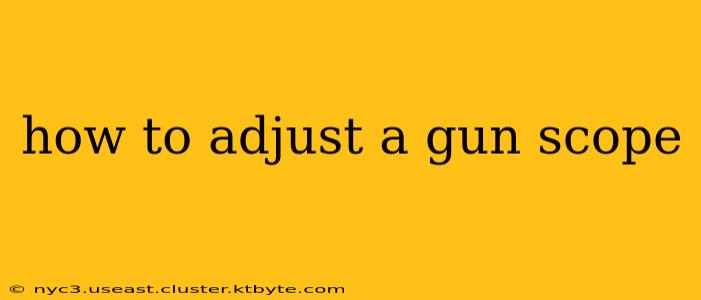Adjusting your gun scope properly is crucial for accurate shooting. Whether you're a seasoned hunter or a novice marksman, understanding how to make these adjustments is essential for hitting your target consistently. This guide provides a step-by-step approach, covering everything from understanding the adjustment knobs to zeroing your scope for optimal performance.
Understanding Scope Adjustments
Before diving into the adjustment process, let's understand the basics. Most gun scopes use a system of windage and elevation adjustments.
-
Windage: This refers to the horizontal adjustment, correcting for left and right shot placement. Turning the windage knob moves the point of impact horizontally. A right-hand adjustment moves the point of impact to the right, and a left-hand adjustment moves it to the left.
-
Elevation: This refers to the vertical adjustment, correcting for high and low shot placement. Turning the elevation knob moves the point of impact vertically. An upward adjustment moves the point of impact upwards, and a downward adjustment moves it downwards.
Most scopes use 1/4 MOA (Minute of Angle) or 1/8 MOA clicks per adjustment. This means each click moves the point of impact a specific amount at a given distance. A 1/4 MOA click will move the bullet's point of impact approximately 1/4 inch at 100 yards. Knowing your scope's click value is essential for accurate adjustments. This information is typically found in your scope's manual. Some scopes also feature milliradian (mil) adjustments.
Step-by-Step Guide to Scope Adjustment
-
Safety First: Always point your firearm in a safe direction, ensuring no one is in the line of fire. Treat every firearm as if it were loaded.
-
Secure Mounting: Confirm that your scope is securely mounted to your firearm. A loose scope will render any adjustment attempts futile and potentially damage the scope or firearm.
-
Choose a Target: Select a target at your chosen zeroing distance (typically 25 yards for pistols and 100-200 yards for rifles). Use a target with clearly defined aiming points.
-
Initial Sighting: Fire several shots at your target. Observe where your shots land relative to your aiming point. This will give you a baseline for your adjustments.
-
Making Adjustments: Based on where your shots landed, adjust your scope accordingly.
- Shots grouped to the left: Turn the windage knob to the right.
- Shots grouped to the right: Turn the windage knob to the left.
- Shots grouped high: Turn the elevation knob downward.
- Shots grouped low: Turn the elevation knob upward.
-
Iterative Adjustment: After making adjustments, fire another group of shots to see if your corrections were effective. Repeat steps 5 and 6 until your shots are grouped where you want them on the target. Remember, small adjustments are usually better than large ones to avoid over-correcting.
-
Zeroing Your Scope: This process involves adjusting your scope until your point of impact (where your bullet hits) matches your point of aim (where you're aiming). This process typically involves several iterations of shooting and adjusting.
Types of Scope Adjustments
While most scopes use the standard windage and elevation adjustments, there are variations. Some higher-end scopes may offer features like:
-
Parallax Adjustment: This adjusts for the difference in the point of impact at different distances, ensuring a clear and sharp image regardless of distance to the target.
-
Reticle Adjustments: Some scopes allow for the adjustment of the reticle itself, for example, changing the brightness or adjusting a rangefinding feature. Consult your scope's manual for specifics.
Troubleshooting Common Issues
-
Inconsistent Grouping: This can be caused by several factors, including poor shooting technique, a faulty scope, or ammunition inconsistencies. Check your shooting form and try different ammunition before suspecting the scope.
-
Scope Not Zeroing: If you can't seem to zero your scope, ensure it's correctly mounted and there are no obstructions interfering with the adjustment knobs.
-
Difficult Adjustments: If the adjustment knobs are stiff or difficult to turn, don't force them. Refer to your scope's manual or consult a professional.
Remember, consistent practice and careful adjustment are key to achieving accurate and repeatable shots with your firearm and scope. Always prioritize safety and consult your scope's manual for specific instructions and safety guidelines.

